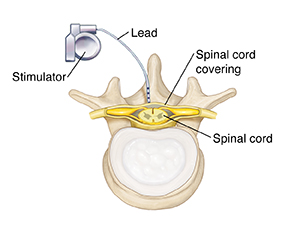Treating Pain with Spinal Cord Stimulators
Spinal cord stimulation is a way to manage various types of pain. A spinal cord stimulator is an implanted device that sends low levels of electricity directly into the spinal cord. Electrical stimulation is a more modern way to stimulate the nerves of muscles to treat pain, and it's been used for more than 30 years. Other methods of this type of stimulation are TENS (transcutaneous electrical nerve stimulation) units, peripheral nerve stimulation, and deep brain stimulation.
Spinal cord stimulators consist of electrodes, or leads, placed in the epidural space around the spinal cord. The electrodes are connected to and powered by a pulse generator or batteries.

Today's spinal cord stimulators allow you to send the electrical impulses into the spinal cord yourself. You use a small device like a remote control. Both the remote control and its antenna are outside your body.
What is spinal cord stimulation used for?
Spinal cord stimulation may be used to treat or manage chronic pain caused by:
-
Back pain, especially back pain that continues even after back surgery (failed back surgery syndrome)
-
Heart pain (angina) untreatable by other means
-
Injuries to the spinal cord
-
Nerve-related pain (such as severe diabetic neuropathy)
-
Peripheral vascular disease
-
Cancer-related pain
-
Complex regional pain syndrome
-
Pain after an amputation
-
Visceral abdominal pain and perineal pain
Spinal cord stimulation seems to be best at easing pain that comes with nerve-related conditions causing pain of the legs or arms and conditions in which oxygen-rich blood flow is limited.
Spinal cord stimulation can improve overall quality of life and reduce the need for pain medicines. Exactly how spinal cord stimulation works to manage pain isn't well understood. But researchers think it may affect the neurochemistry of the spinal cord.
Spinal cord stimulation technology
Spinal cord stimulators come in three main types:
-
Conventional implantable pulse generator, or IPG. A battery is placed in the spine during an operation. When it runs out, the battery must be replaced in another surgery. This can be a good choice for people with pain in just one body part because they need less energy to manage their pain.
-
Rechargeable implantable pulse generator. A battery is placed in the spine during an operation. You can recharge it without another surgery. Because the energy source is rechargeable, these stimulators can put out more electricity. This may be a better choice for people with pain in the lower back or in one or both legs. The device is more powerful than conventional IPGs.
-
Radiofrequency stimulator. This type of stimulator is an older design. It uses a battery that's outside the body. This stimulator is rarely used today because of newer designs and better technology. This includes rechargeable batteries. But like the rechargeable IPGs, these may be better for people with pain in the lower back and legs because of the device's power.
With any type of spinal cord stimulators, you control the level of electricity sent to the spine to make the treatment work better.
Spinal cord stimulation is an expensive treatment that does involve risk because of the major surgery needed to put the device in place. Spinal cord stimulation is usually used along with other pain management treatments. These include medicines, exercise, and relaxation methods. Spinal cord stimulation is used only when other pain management methods haven't helped to ease your pain.